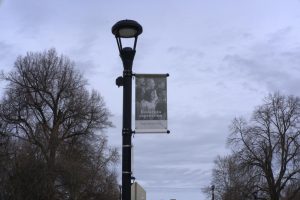Climate Change in the Walla Walla Valley
May 17, 2016
Many Waters
Walla Walla is a Sahaptin phrase often translated as “many waters.” The Walla Walla tribe, and now the Confederated Tribes of the Umatilla Indian Reservation, share history with the local Cayuse tribe. In many ways, the name of Walla Walla most closely connects the town to its indigenous history. With climate change looming large on the horizon, what is the fate of groundwater and streams in this area named after abundance?
“There’s certainly parts of it that nobody knows the answer to,” said Nick Bader, Professor of Geology.
Conservation biologist Mike Denny believes that efforts to increase riverbank health should include replanting native species. He is a strong proponent of restoration, and cites Walla Walla’s staggering 200 miles of stream revitalization efforts with pride.
“Those trees put shade on the river and in the creeks to keep the water cool and to allow salmon and steelheads to survive. The big question is- will it work when our climate continues to increase in temperature? That remains to be seen,” said Denny.
Although there are local organizations, such as the Tri-State Steelheaders and Kooskooskie Commons, that focus on stream restoration, Bader explains that city efforts at conservation can be the most effective. The city maintains seven deep wells that allow officials to draw on stored water in the summer, when moisture is scarce.
“In the wintertime when there’s excess water, they can treat additional water and actually just pump it back down underground and it’s basically just being banked in the aquifer for the next year,” said Bader. “So as far as that sort of thing goes, Walla Walla’s in an unusually good position to deal with problems. We’re really not drawing down the basalt aquifer by that municipal use because of this project.”
Ultimately, a healthy stream system will be able to better protect aquatic species, and others that depend on reliable streamflow. However, it is difficult to project how climate change might alter the Walla Walla watershed.
“The globe is going to warm on average … and how that [warming] is distributed is not very well known at all, right?” said Bader. “And all we have to go on here is computer models, which in some cases are really consistent and in other cases say different things, depending on the model. At least the last time I checked they were not very strongly in agreement around here, so I’m not sure. Basically, we don’t know.”
Fire Season
The past few summers in Walla Walla have been unusually long and hot.
“What’s interesting is climate change over time is actually going to extend the fire season,” said Phil Brick, Miles C. Moore Professor of Politics. “Normally we don’t see the beginning of fires right now in many parts of the country but we’re seeing them. So that’s kind of a precursor of what’s to come. For example, the dogwood trees that are blooming here on campus. It’s not even May yet. I’ve seen those dogwood trees bloom with students in the foreground marching at commencement in late May.”
Although early flower blooms may not seem like an ominous sign, seasonal variation can cause more problems than a graduation without dogwood blossoms. As Bader explains, an earlier summer can strain Walla Walla’s water supply.
“The nature of Walla Walla is, of course, that it has its own mini-drought every summer,” said Bader. “And if you’re interested in climate change, I think that’s the part that’s interesting around here … the fact that we have this really uneven distribution of the water supply so the water supply is most abundant in the winter and the need for that water is, of course, the greatest in the summer.”
Denny is also cautious of the prospect of longer, hotter and drier summers. Although this outcome cannot be predicted with certainty, local weather patterns suggest the trend. Climate variation is being compounded with the introduction of cheatgrass, a highly invasive and flammable species, to the area.
“The Umatilla National Forest was known as the Teflon Forest because it never burned,” said Denny. “Now, every year, we get more and more fires, and it continues to increase. Everyone likes to point their finger and say that management caused this to go. But, the truth is that we dry out quicker and we dry out longer, and people aren’t very careful.”
This increased frequency and intensity of fires leaves local firefighters and land management officials under mounting stress. As local forests become more vulnerable to forest fires and mega-fires, risk management becomes increasingly difficult. In the end, awe and uncertainty can take over, making devastating fires one of many incredible effects of climate change.
“Things are happening all over the place in Southeast Washington that kind of blow me away,” said Denny. “You can see how this weather pattern shift is affecting everything. I mean everything. We don’t really understand now, looking down the road into the future, how this is really going to affect this.”
Vineyards: The global warming winners
While many areas of the Walla Walla Valley are suffering because of climate change, vintners in the area seem to have gotten the better end of the deal. While wineries in Napa Valley and Southern California are suffering under conditions of extreme heat and drought, wineries in the Pacific Northwest continue to thrive.
Whitman College Professor of Geology Kevin Pogue has spent the last eleven years studying Walla Walla terroir–the physical environment for growing grapes. Historically, grapes in the area have trouble with frosts in early October. Pogue says that climate change has actually decreased the risk of vineyards freezing by extending the warmer summer months later into the fall.
“Right now, if you could describe how global warming is affecting vineyards here, they’re loving it. It is giving them a better chance of getting their grapes ripe before the first frost or freeze,” said Pogue.
This is not the case for wineries in the Napa Valley. Californian vintners have run into problems the last few years with vineyards having much warmer temperatures in the early morning. The grapes are not able to shut down overnight because of the increased temperature, so they ripen much faster. As a result, many Californian wineries are experiencing excess alcohol and sugar in their wine. Many wineries are moving further north or to higher elevations to adapt to the changing temperatures.
Though Walla Walla wineries are reaping the benefits of climate change, many still push for sustainable practices in an effort to reduce their footprints.
Seven Hills winemaker and founder Casey McClellan has been harvesting grapes in the valley since 1988, making Seven Hills one of the oldest wineries in the area. McClellan has seen the Walla Walla wine industry develop over the last few decades into a booming business that has an enormously positive effect on the local economy. However, he believes that with the economic growth comes environmental responsibility.
“As [the wine industry] gets bigger, what we do in the environment matters more because it has more of an effect,” said McClellan, who believes water conservation may be one of the most important efforts in winery sustainability. “Water is becoming more and more precious, and a resource that we really need to take care of with consideration and with a long term view.”
Shifting Skies
Fifteen thousand snow geese landed in the McNary National Wildlife Refuge this past February, far surpassing all prior counts. Their white bodies dotted the Columbia River like puffs from cotton trees, their black-tipped wings delicately slicing through the surface of the river.
While it’s a breathtaking sight, these geese have moved to Walla Walla County because climate change forced their habitat to change.
“Things are happening all over the place in Southeast Washington that kind of blow me away,” said Walla Walla conservation biologist Mike Denny.
Denny served for over a decade as the president of the Blue Mountain Audubon, a local nonprofit that strives to appreciate, preserve and enjoy birds and wildlife in the Walla Walla area. This year in particular, he witnessed many changes in bird species. Denny was shocked this winter when hundreds of shad–small, silver fish found in the Snake River–died, attracting many new species of birds.
The cause of death? Starvation.
“They shouldn’t even be in the river, but here they were, way up in the Snake River in the dead of winter. They starved to death because they didn’t have food. They starved to death by the thousands,” said Denny. “We started seeing dozens and dozens of them, and then hundreds and hundreds of them. Everyone was finding them. The die-off attracted birds that have never been here before.”
Birdwatchers began to see strange, unusual species in the area that had come to feast on the dead shad, including over ten different kinds of gulls. However, this instance is not the only significant shift in bird populations.
Associate Professor of Biology Tim Parker believes wildfires that destroy all sagebrush in the area have also caused a decrease in bird populations. This has particularly affected birds like the sagebrush sparrow, sage thrasher and the sage grouse, all of which are dependent on sagebrush for food and shelter.
“In the Columbia Basin in general, with the vegetation drying out much earlier, there is a much greater risk of fire. Fire has large effects on these low elevation ecosystems,” said Parker.
However, Parker doubts that changes in these species will dramatically affect the local ecology.
“We are in a period when ecosystems are moving really fast because people are moving species around and people are actively driving the extinction of species, but also because of climate change,” said Parker.
The changes in populations of snow geese, shad and sagebrush are just a few examples of a large shift in wildlife and plant life in Eastern Oregon and Washington due to climate change. Drought and increased temperatures over the last few years have forced some species to leave the area entirely and allowed others to thrive in their wake.
“Walla Walla County is a radically changed place already. It’s true in the mountains and it is even more true down in the valley,” said Parker.
Denny is positive that these species shifts are a sign of much larger, systematic change in the environment. “I am always amazed when people say there isn’t climate change. All of the organisms I see changing drastically over a short period of time tells me that something is really afoot here.”







